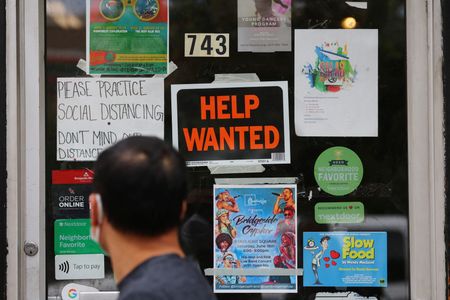By Lucia Mutikani
WASHINGTON (Reuters) – U.S. job openings fell less than expected in November as the labor market remains tight, which could see the Federal Reserve boosting interest rates to a higher level than currently anticipated to tame inflation.
There was, however, encouraging news in the inflation fight, with a survey from the Institute for Supply Management (ISM) on Wednesday showing its measure of prices paid by manufacturers for inputs diving in December to the lowest level since February 2016, discounting the plunge early in the COVID-19 pandemic.
The Fed is engaged in its fastest interest rate-hiking cycle since the 1980s as it tries to dampen demand, including for labor, to quell inflation. Last month, the U.S. central bank projected interest rates could rise to a peak of 5.1%. But persistent labor market tightness has led economists to expect that borrowing costs will increase to a much higher level and remain there for a while.
“The labor markets are still too darn hot for policymakers,” said Christopher Rupkey, chief economist at FWDBONDS in New York. “Fed officials won’t be confident their monetary tightening is working until hiring demand begins to slow.”
Job openings, a measure of labor demand, slipped 54,000 to 10.458 million on the last day of November, the Labor Department said in its monthly Job Openings and Labor Turnover Survey, or JOLTS report. Data for October was revised higher to show 10.512 million openings instead of the previously reported 10.334 million. Economists polled by Reuters had forecast 10 million job openings.
There were 1.74 jobs for every unemployed person in November. Professional and business services reported an additional 212,000 job openings, while vacancies increased 39,000 in nondurable goods manufacturing.
But job openings dropped 75,000 in finance and insurance, one of the industries hardest hit by higher borrowing costs, and fell 44,000 in federal government.
The job openings rate was unchanged at 6.4%, though it was 0.9 percentage point below its peak in March 2022. Hiring fell to 6.055 million from 6.111 million in October. But hiring increased 74,000 in the healthcare and social assistance sector. The hiring rate dipped to 3.9% from 4.0% in October.
The Fed last year hiked its policy rate by 425 basis points from near zero to a 4.25%-4.50% range, the highest since late 2007. Last month, it projected at least an additional 75 basis points of increases in borrowing costs by the end of 2023.
Minutes of the Fed’s Dec. 13-14 policy meeting published on Wednesday showed officials acknowledged “significant progress” over the past year to bring inflation down and thought the central bank now needed to balance its fight against price pressures with the risks of slowing the economy too much and “potentially placing the largest burdens on the most vulnerable groups” through higher-than-necessary unemployment.
Stocks on Wall Street were mostly higher. The dollar fell against a basket of currencies. U.S. Treasury prices rose.
MORE RESIGNATIONS
The still-tight labor market conditions were reinforced by a 125,000 increase in the number of people resigning from their jobs to 4.173 million in November. That lifted the quits rate, viewed by policymakers and economists as a measure of job market confidence, to 2.7% from 2.6% in the prior month. Higher resignations could keep wage growth elevated and ultimately inflation. Layoffs fell 95,000 to 1.350 million.
“Workers overwhelmingly quit their old jobs to take new ones, which is a critical fuel for wage growth,” said Nick Bunker, head of research at Indeed Hiring Lab. “The flipside of workers leaving their old jobs readily is that employers aren’t letting go of the workers that remain.”
In a separate report, the ISM said its measure of prices paid by manufacturers dropped to 39.4 from 43.0 in November. The ninth straight monthly decrease reflected fading demand for goods, which are typically bought on credit.
Supply chains are improving and Americans are shifting spending away from goods to services as the nation moves to a post-pandemic era. The ISM survey’s forward-looking new orders sub-index tumbled to 45.2, the lowest since May 2020, from 47.2 in November. It was the fourth straight month this measure has been in contraction territory.
Its measure of supplier deliveries fell to 45.1 from 47.2 in November, remaining below the 50 threshold, which indicates faster deliveries to factories, for a third consecutive month. The month-over-month performance of supplier deliveries was the best since March 2009, according to ISM.
Goods prices are falling on a monthly basis, while the annual increase has slowed considerably. Economists expect goods deflation this year. Services will, however, continue to exert upward pressure on inflation.
With demand slumping, manufacturing contracted for a second straight month in December with ISM’s manufacturing PMI dropping to 48.4 from 49.0.
That was the weakest since May 2020 and pushed the index just below 48.7, which the ISM says is consistent with a recession.
But with the labor market still pumping out jobs and sustaining consumer spending, it is unlikely the economy is in recession.
A PMI below 50 indicates contraction in manufacturing, which accounts for 11.3% of the U.S. economy. The survey’s measure of factory employment rebounded to 51.4 from 48.4 in November.
Comments from manufacturers ranged from “huge” skilled labor shortages in the computer and electronic products industry to orders “really” slowing in the transportation equipment sector, and “customers delaying their commitments for capital purchases” in the machinery production industry.
(Reporting by Lucia Mutikani; Editing by Andrea Ricci and Chizu Nomiyama)

